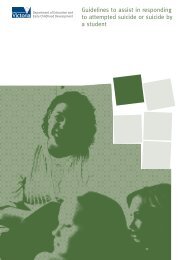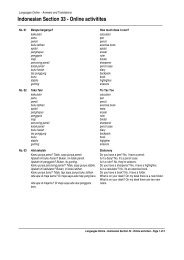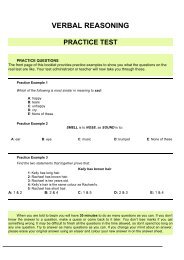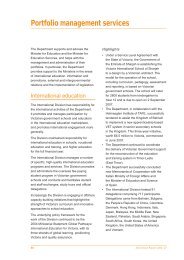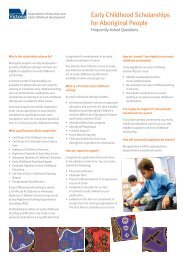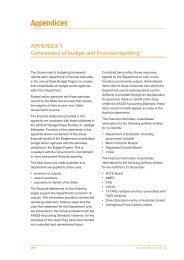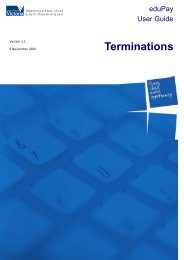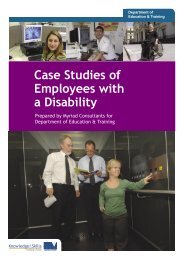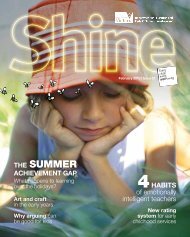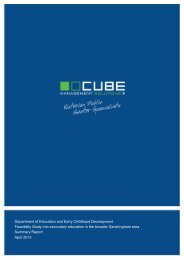November 2009 Vol. 1, Issue 10 (PDF - 16.2Mb) - Department of ...
November 2009 Vol. 1, Issue 10 (PDF - 16.2Mb) - Department of ...
November 2009 Vol. 1, Issue 10 (PDF - 16.2Mb) - Department of ...
You also want an ePaper? Increase the reach of your titles
YUMPU automatically turns print PDFs into web optimized ePapers that Google loves.
Australia’s employment rate for<br />
people with disabilities recently<br />
ranked 13 out <strong>of</strong> 19 OECD<br />
member countries surveyed<br />
(OECD 2007). It was also the lowest <strong>of</strong> 16<br />
countries for employment <strong>of</strong> people on a<br />
disability-related benefit, and the highest <strong>of</strong><br />
the 16 countries for failing to engage people<br />
on a disability-related benefit in paid work.<br />
The Disability Discrimination Act 1992 requires<br />
that students with a disability are treated ‘on the<br />
same basis’ as other students and that ‘reasonable<br />
adjustments’ be made to provide these students<br />
with the opportunities and choices comparable<br />
to those available to students without disabilities.<br />
However, a national inquiry into employment<br />
and disability found that in 2003 only 53 per<br />
cent <strong>of</strong> people with a disability participated<br />
in the workforce (Human Rights and Equal<br />
Opportunity Commission 2005). Of particular<br />
concern are the findings that people with a<br />
disability were under represented in<br />
vocational training and training systems, and<br />
that there were poor links between school and<br />
post-school programs.<br />
The Australian Association <strong>of</strong> Special Education<br />
(AASE) and the Principals’ Association <strong>of</strong><br />
Specialist Schools Victoria (PASS) addressed<br />
these issues at the nation’s major special<br />
education conference, Transitions: Facilitating<br />
Change for Students with Special Needs, held<br />
in Melbourne earlier this year. The conference<br />
provided educators and policy makers with high<br />
quality research to drive best practice in student<br />
transitions from early childhood to adult and<br />
post-school options, not only in Victoria but<br />
across Australia.<br />
Dr Denis Meadows examined the Australian<br />
transitions in the Des English Memorial Lecture<br />
entitled Where did all our students go? Postschool<br />
outcomes for students with a disability<br />
(Meadows <strong>2009</strong>). He discussed his report to the<br />
Queensland Government looking at outcomes<br />
for students who had left Queensland schools<br />
from 2000–05. He found a gap in the research<br />
literature on this subject for Australia, and while<br />
there were some project reports, they were mostly<br />
descriptive with little outcome data.<br />
Making your way in a cold world – promoting<br />
the school-to-community transition success<br />
<strong>of</strong> adolescents with emotional or behavioural<br />
disabilities was the keynote presentation by<br />
Pr<strong>of</strong>essor Michael Bullis, Dean <strong>of</strong> the College <strong>of</strong><br />
Education and Sommerville-Knight Pr<strong>of</strong>essor<br />
<strong>of</strong> Education, Secondary Special Education and<br />
Transitions Research at the University <strong>of</strong> Oregon<br />
in the United States. Pr<strong>of</strong>. Bullis highlighted the<br />
current research relating to vocational transitions<br />
and employment for adolescents with disabilities<br />
and emotional and behavioural disorders. He<br />
advocated a developmental approach for schoolto-community<br />
transition with five vocational<br />
phases: learning, responsibility, transition,<br />
independence and employability.<br />
The key components in the final school year,<br />
for a successful transition to post school<br />
options, are: year-round services; consistent<br />
routines; high expectations; academic learning;<br />
competitive work; a realistic focus; and real-life<br />
decision making. Pr<strong>of</strong>. Bullis argued for a wellplanned<br />
approach, wide ranging educational<br />
strategies that encompass key program<br />
structures and components, educators who<br />
specialise in transition, community partnerships,<br />
administrative challenges, multi-agency<br />
collaboration and staff training (Bullis <strong>2009</strong>).<br />
The workshop, Should you always agree with<br />
the boss? Job-related social skills training for<br />
adolescents, addressed the essential elements<br />
<strong>of</strong> work: social skills, communication, body<br />
language, interaction with supervisors and<br />
co-workers, and problem solving, within a<br />
framework <strong>of</strong> Working at Gaining Employment<br />
Skills (WAGES). Pr<strong>of</strong>. Bullis maintains the<br />
importance <strong>of</strong> foundation skills and attitudes:<br />
locus <strong>of</strong> control, teamwork, communication,<br />
problem solving, enthusiasm, dependability and<br />
honesty as the essentials in building social skills<br />
and resilience for the workplace. This, coupled<br />
with instruction and on-the-job training, is the<br />
hallmark <strong>of</strong> a successful transition to work.<br />
The 1960 initiative <strong>of</strong> Montague Special<br />
School in South Melbourne to create the first<br />
work experience program in a Victorian school<br />
established a model and process for all schools.<br />
Heatherwood School in Donvale is just one<br />
<strong>of</strong> many schools now using this model. The<br />
school has 250 school-age students with a mild<br />
intellectual disability, many <strong>of</strong> them having<br />
another underlying disability such as emotional<br />
or behavioural disorders.<br />
Heatherwood <strong>of</strong>fers in situ training models<br />
in the community (for example, at Waverley<br />
Industries and Boronia Gym) covering work<br />
experience, work placement, traineeships, and<br />
apprenticeships. Mark Walker, the transition<br />
work placement coordinator and author <strong>of</strong> the<br />
Learn to Work program, has developed a range<br />
<strong>of</strong> employment opportunities for more than 40<br />
senior students in Years 11 and 12. The strength<br />
<strong>of</strong> the program is its emphasis on individual<br />
students’ aspirations, the strong collaborations<br />
with students, families, employers and agencies,<br />
the intensive training and negotiations with all<br />
stakeholders, as well as targeted skills instruction<br />
in the classroom. The program produces<br />
successful outcomes and there are similarities<br />
with the research that both Bullis and Meadows<br />
have presented. Heatherwood collaborates with a<br />
broad range <strong>of</strong> employers, providers and agencies<br />
so that all students experience a range <strong>of</strong> work<br />
experience as they progress through the school.<br />
In preparing all adolescents for a future life, it<br />
is important to provide the vital pathways and<br />
transitions that young people need in order to<br />
grow into well-rounded adults. Work provides<br />
opportunities for practising friendship skills,<br />
community and lifelong learning. Both the<br />
research and experience show that by improving<br />
Xxxx<br />
Shine 53<br />
Research<br />
preparation and planning, the outcomes are<br />
improved. The emphasis on emotional and social<br />
learning and interpersonal development, not<br />
only in the latter years, but from an early age, is<br />
central to positive student outcomes in all areas<br />
<strong>of</strong> learning. A systematic approach in training for<br />
work and life, where practice is research based,<br />
where standards and opportunities formulated<br />
under the Disability Discrimination Act 1992<br />
are embedded, allows young people with a<br />
disability to live ‘an ordinary life’.<br />
Prepared by Lesley Foster, president <strong>of</strong> the Australian<br />
Association <strong>of</strong> Special Education Victorian Chapter<br />
and assistant principal <strong>of</strong> Heatherwood School,<br />
Donvale; Tony Thomas, executive <strong>of</strong>ficer, Principals’<br />
Association <strong>of</strong> Specialist Schools; and Wendy Castles,<br />
special education consultant, DEECD Latrobe<br />
Valley Network Student Support Services team.<br />
References<br />
Commonwealth <strong>of</strong> Australia 2006, Disability Standards<br />
for Education 2005, Attorney-General’s <strong>Department</strong><br />
& <strong>Department</strong> <strong>of</strong> Education, Science and Training,<br />
Canberra. Available at www.dest.gov.au/sectors/school_<br />
education/programmes_funding/forms_guidelines/<br />
disability_standards_for_education.htm<br />
Bullis, M. <strong>2009</strong>, Making your way in a cold world:<br />
promoting the school to community transition.<br />
Proceedings <strong>of</strong> the <strong>2009</strong> AASE/PASS National<br />
Conference, Melbourne.<br />
Bullis, M. & Fredricks, H.D. (eds) 2002, Vocational and<br />
transition services for adolescents with emotional and<br />
behavioural disorders: strategies and best practices,<br />
Research Press, Champaign IL.<br />
Johnson, M. D., Bullis, M., Benz, M. R. & Hollenbeck,<br />
K. 2004, W.A.G.E.S. Working at Gaining Employment<br />
Skills, A Job-Related Social Skills Curriculum for<br />
Adolescents, Sopris West, Educational Services,<br />
Longmont, Colorado.<br />
Human Rights and Equal Opportunity Commission<br />
2005, WORKability II: Solutions - People with disability<br />
in the open workplace. Final Report <strong>of</strong> the National<br />
Inquiry into Disability and Employment, HREOC,<br />
Sydney. Available at www.humanrights.gov.au/<br />
disability_rights/employment_inquiry/index.htm<br />
Meadows, D. et al. 2006, Quality outcomes for<br />
students with a disability. Research project – Executive<br />
Summary, Queensland Government <strong>Department</strong> for<br />
Education, Training and the Arts, Brisbane. Available<br />
at http://education.qld.gov.au/studentservices/learning/<br />
disability/qualityoutcomes.html<br />
Meadows, D. <strong>2009</strong>, Where have all our students<br />
gone? School to post-school transition in Australia.<br />
Proceedings <strong>of</strong> the <strong>2009</strong> AASE/PASS National<br />
Conference, Melbourne.<br />
Organisation for Economic Co-Operation and<br />
Development 2007, Sickness, disability and work:<br />
breaking the barriers – Australia, Luxembourg, Spain<br />
and the United Kingdom, vol 2, OECD, Paris.<br />
Roberts, E. & Griffin, P. <strong>2009</strong>, Pr<strong>of</strong>iling transitions in<br />
emotional development for students with additional<br />
learning needs. Proceedings <strong>of</strong> the <strong>2009</strong> AASE/PASS<br />
National Conference, Melbourne.



